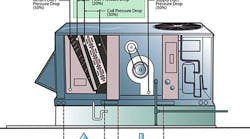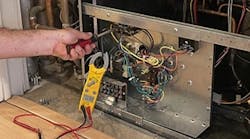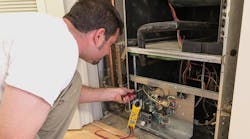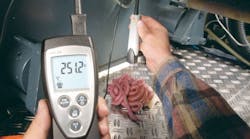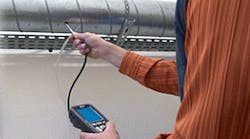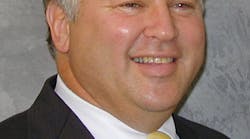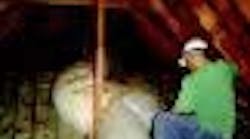Last week, David Richardson and I taught HVAC classes at the Midwest Residential Energy Conference in Lexington Kentucky. We had a blast. Somehow the HVAC and energy rater industries have found harmony in that region. The politics and the weird variations in culture were not in the way. We got down to the business of testing and improving the performance of HVAC systems that reached far beyond the usual home energy audit.
Typically, HVAC contractors have a general belief that energy raters come up short when it comes to testing and diagnosing an HVAC system. Performing a duct-tightness test and recording nameplate data has always failed to prove whether or not a system is performing in the eyes of savvy HVAC professionals. Something about this group of raters made them different though. They didn’t accept what they had been led to believe and were searching for more.
In Kentucky, this large group of excellent energy raters stepped way outside their normal comfort zone and embraced the idea that the average HVAC system operates below 60% of rated capacity. Armed with that knowledge, many of these seasoned raters swallowed hard and admitted that without measuring and rating the operating efficiency of HVAC systems, the typical home energy audit falls drastically short of revealing a home’s true energy story.
By measuring an HVAC system’s operating efficiency, hidden energy savings are uncovered. An additional 30% or more of savings can be measured and verified after a system is renovated. This energy savings is greater than are the efficiency increases that come from replacing equipment alone.
Side-by-side, HVAC professionals and energy raters learned to test, diagnose, and repair HVAC systems using procedures that are very different from the building science methods they were accustomed to using. Static pressure profiles, measurement of live duct airflow, temperature losses, and the measurement of delivered system BTUs into the building envelope were among the skills they learned.
Many discussions were held about how energy raters can work alongside HVAC professionals and increase their offerings to their customers. Instead of simply providing a homeowner with a list of defects in their home, raters can work with HVAC and insulation contractors to make specific recommendations and coordinate this work with other energy professionals.
Imagine these trades consistently partnering with each other and working together outside of incentive programs. How cool would that be?
The home performance industry has been dominated by the building science community, leaving most of the HVAC industry as outsiders looking in. The disconnect between what most home energy audits report and what HVAC contractors measure have been quite polarized in the retrofit market outside of utility programs. At this conference we witnessed the two groups unifying and supporting one another. Could this be a model for things to come in the near future?
The Energy Efficiency Sales Process
HVAC contractors have repeat customers where relationships are sustained over many years and where the purchase of efficiency is an evolving process. Energy raters normally have just one shot at a customer to make an impact and establish a relationship at the time of an energy audit. For raters, this is a difficult environment to have success in.
Successful contractors have built organizations that make the energy upgrade decision one streamlined process instead of a one shot sale. Service departments uncover system and building defects and help customers become aware of the comfort and energy savings opportunities. The service department arranges a seamless meeting with their company’s comfort and efficiency consultant who educates the customer and provides pricing options that fit their budget. He or she then introduces the customer to the installation crew and hands off the job. Then the company’s verifiers test and optimize the system at the completion of the job. This all happens seamlessly within one company in just a couple of days.
Unless a contractor engages an energy rater as a team player in this process, the odds of the rater's success are very limited in the retrofit market. This is painfully evident in California where energy rater’s inspections have been made a mandatory requirement of the permitting process for HVAC jobs. In this broken scenario, only 2% to 5% of HVAC jobs include a building permit. It doesn’t have to be this way.
Unfortunately, home performance has evolved into something different than what the HVAC industry offers. There has been an attempt to fund into existence a new industry which the building science community captured and has dominated. Although much good has come from it, that industry as a whole has failed to sustain itself in the retrofit market.
What if . . . ?
What if energy raters were to move beyond their role as providers of energy audits and building ratings? What if energy raters would test, diagnose, and actually rate an HVAC system? In Kentucky, we found ready and able energy raters and HVAC contractors willing to partner in expanding their services together to deliver measured and documented HVAC systems to their customers.
We invite others to follow their lead and discover an additional 30% or greater HVAC system energy savings. These savings have been hidden from the building science community because the measurement of operating system efficiency has been absent from their testing protocols.
Here's a chance to fix that an allow HVAC contractors and Energy Raters to work together profitably.
Rob “Doc” Falke serves the industry as president of National Comfort Institute, an HVAC-based training company and membership organization. If you're an HVAC contractor or energy rater interested in duct temperature loss measurement procedure, contact Doc at [email protected] or call him at 800-633-7058. Go to NCI’s website for free information, articles and downloads.
